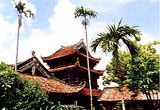|
 NAMDINH
NAMDINH
|
Co Le Pagoda
Co Le pagoda is situated in the town of Co Le, Truc Ninh district
of Namdinh province, about 15 kms from the center of the
provincial town. As legend has it, this pagoda was built by the
monk Thich Minh Khong under the Ly dynasty. It had been renovated
several times during the course of history. The present pagoda was
built by Buddhist reverend Pham Quang Tuyen in 1920.
In front of the pagoda lies the 12-story Cuu Pham Lien Hoa (Nine
colors of the lotus flower) tower; the base of the tower has the
shape of a turtle. There is a 60-step spiral staircase in the
tower. Visitors can climb the steps to the top of the tower for a
magnificent view of the neighborhood. |
Pho Minh Pagoda |
Pho Minh Pagoda
(The ruins of Tran dynasty palaces)
Tuc Mac village is situated on the west end of Namdinh town,
about 3 kms from the town's center. This is the home village of
the first King of the Tran dynasty, and the birthplace of General
Tran Hung Dao, the most talented general in Vietnam's history who
had defeated the Mongols 3 times. The ruins of the Tran dynasty
palaces scatter in an area tens of thousands of square meters,
including Thien Truong and Co Trach temples dedicated to the Tran
Kings and Tran Hung Dao, and Pho Minh Pagoda.
This pagoda was erected during the Ly dynasty and was expanded in
1262 under a decree by a King of the Tran dynasty. This is a large
pagoda with lake pavilion, lotus pond, and many giant trees. There
is an enormous bronze incense burner in front of the pagoda that
weighs 7 tons.
A tower in the shape of a lotus, 21 meters and 13 storied high,
was built within the vicinity of the pagoda in 1305. This is an
architectural wonder as the 700-tonn tower relies on a base of
only 30 m2 in an area of weak land foundation but has remained
where it is today for 700 years.
 THAIBINH
THAIBINH
|
Keo Pagoda
(The pagoda of the Divine Light)
From Hanoi, one can take a bus to the town of Namdinh. After
crossing the Red river at the Tan De Ferry station and riding
along the Red River dyke, one will reach Keo Pagoda. From the
dyke, one can see a panorama view of the whole pagoda on the
background of the green rice fields of Duy Nhat commune, Vu Thu
district, and Thaibinh province. |

Keo
Pagoda |
The pagoda lies on an area of 108,000 square meters, 58,000 square
meters of which is occupied by 17 structures. The bell tower of
Keo Pagoda is a work of art typical of Vietnam's wooden joint
construction technique of 17th century.
 NINHBINH
NINHBINH
|
Telephone code: ( 84-30 )
Area: 12,556 km2
Population: 4,459,000
The region of Ninhbinh has been privileged by nature, with the
Day River, the Van Sang River, the Non Nuoc and Canh Dieu
Mountains, etc. Ninhbinh has evolved into a major travel centre.
|
Thai Vi temple - Ninhbinh |
Hoa Lu
Hoa Lu was the capital of Vietnam under the Dinh Dynasty (968 -
980) and the early Le Dynasty (980 - 1009). The site was an
attractive place for a capital city because of both its distance
from China and the natural protection afforded by the region's
bizarre landscape.
Tam Coc
Taking a sampan trip, visitors reach Tam Coc Caves that consist of
Hang Ca, Hang Hai and Hang Ba Caves. They are adorned with
beautiful stalactites and stalagmites in different shapes and
colors, sparkling like gemstones.
Bich Dong
Bich Dong Grotto is located in Ngu Hanh Son Mountains in Dam
hamlet. A short sampan trip takes you into beautiful landscapes
with channels meandering between high rocks and grottoes. Charmed
by the marvelous scenery, the Tu Duc King gave Bich Dong the
titles of "the second most beautiful grotto in Vietnam".
Phat Diem
Phat Diem was built between 1875 and 1898, is the site of a
cathedral remarkable for its vast dimensions and unique Sino -
Vietnamese architecture. The vaulted ceiling is supported by
massive lime wood columns almost one meter in diameter and 10m
tall. In the lateral naves, there are a number of curious wood and
stone sculptures. The main altar is made of a single block of
granite. Phat Diem is one of the important centre of Catholicism
in the North.
Cuc Phuong National Park
It is one of Vietnam's most important nature preserves. Though
wildlife has suffered a precipitous decline in Vietnam in recent
decades, the park's 222 sq km of primary tropical forest remain
home to an amazing variety of wildlife, including 1967 species of
flora from 217 families and 749 genera with some trees of the Parashorea and Dracontomelum families reach 1,000 years of age and
from 50m to 70m in high, 1800 species of insects from 30 orders
and 200 families, 137 species of birds, 64 species of animals and
33 species of reptiles. Among the extraordinary variety of life
forms in the park are several species discovered here, including a
tree know as Bressaopsis Cucphuongensis and the endemic
red-bellied squirrel Callosciurus erythrinaceus Cucphuongensis.
The Rhesus macaque (Macaca mullata) can sometimes be seen in the
forests. In Con Moong cave, one of the park's many grottoes, the
stone tools of prehistoric humans have been discovered.
|

